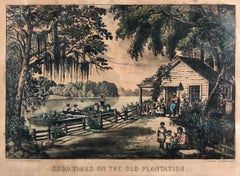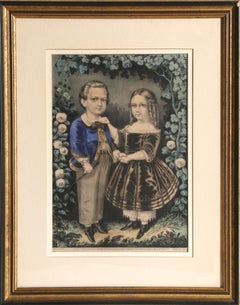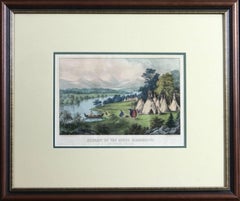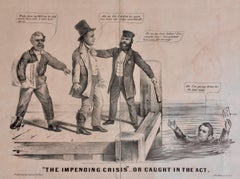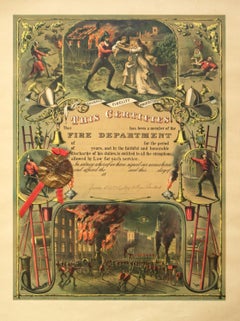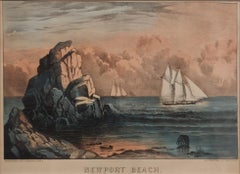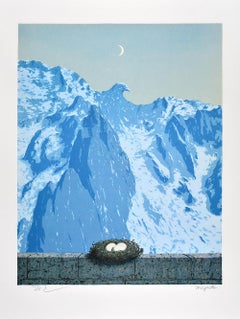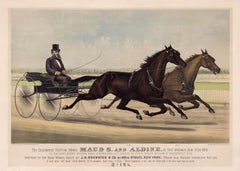Currier & Ives Figurative Prints
American, 1834-1907
Currier and Ives was a prominent American printmaking establishment headquartered in New York operating from 1835 to 1907. Nathaniel Currier (1813-1888) started his business on his own, but later merged with James Merritt Ives (1824-1895), becoming "Currier and Ives" in 1857. They produced and sold hand-colored lithographs which could be produced relatively quickly and cheaply. They called themselves "the Grand Central Depot for Cheap and Popular Prints". The company published around 7,500 lithographs in its 72 years in business.to
3
2
1
Overall Width
to
Overall Height
to
20
859
382
376
308
5
1
1
4
2
4
3
2
2
2
1
1
1
1
1
1
1
1
1
1
1
6
1
1
6
Artist: Currier & Ives
Good Times on the Old Plantation
By Currier & Ives
Located in Missouri, MO
Currier & Ives (Publishers)
"Good times on the Old Plantation" 1872
Handcolored Lithograph
Size Height 10 in.; Width 13.9 in.
Framed Size: approx 16 x 19.5
Category
1870s Victorian Currier & Ives Figurative Prints
Materials
Lithograph
Boy and Girl, Hand-Colored Lithograph by Currier & Ives
By Currier & Ives
Located in Long Island City, NY
Artist: Currier and Ives
Title: Boy and Girl
Year: circa 1863
Medium: Hand-colored lithograph
Size: 11 x 8 in. (27.94 x 20.32 cm)
Frame Size: 16 x 14 inches
Category
1860s Victorian Currier & Ives Figurative Prints
Materials
Lithograph
Scenery of the Upper Mississippi Indian Village Currier & Ives lithograph framed
By Currier & Ives
Located in Paonia, CO
Scenery of the Upper Mississippi Indian Village Currier & Ives lithograph is a tranquil scene of an Indian village camped in a meadow next to a be...
Category
Mid-19th Century American Realist Currier & Ives Figurative Prints
Materials
Lithograph
CURRIER & IVES - 1860 LINCOLN ELECTION CAMPAIGN
By Currier & Ives
Located in Santa Monica, CA
CURRIER & IVES (LOUIS MAURER)
1860 LINCOLN ELECTION CAMPAIGN
THE IMPENDING CRISES - OR CAUGHT IN THE ACT, 1860 (C.3033, G.3270)
Lithograph...
Category
1860s Other Art Style Currier & Ives Figurative Prints
Materials
Lithograph
Fire Department Certificate pub. by Currier & Ives 1911
By Currier & Ives
Located in Paonia, CO
This is an original certificate of honorable discharge from the Saratoga New York Fire Department. It is signed by the Village President and dated 1911...
Category
1910s Other Art Style Currier & Ives Figurative Prints
Materials
Lithograph
"Newport Beach" Currier & Ives, Hand-Colored Lithograph of Newport Beach
By Currier & Ives
Located in New York, NY
Currier & Ives
Newport Beach
Hand-colored lithograph
Sheet 10 x 13 1/4 inches
After undertaking apprenticeships in Boston and Philadelphia, Currier set up a print publishing compan...
Category
Late 19th Century Realist Currier & Ives Figurative Prints
Materials
Lithograph
Related Items
ABOVE THE CLOUDS
Located in Aventura, FL
Lithograph on paper. Hand signed, titled and numbered by the artist. Edition of 350.
Artwork is in excellent condition. Certificate of Authenticity is included. All reasonable o...
Category
1990s Realist Currier & Ives Figurative Prints
Materials
Paper, Lithograph
René Magritte - LE DOMAINE D'ARNHEIM Limited Surrealism French Contemporary
By (after) René Magritte
Located in Madrid, Madrid
René Magritte - LE DOMAINE D'ARNHEIM, 1962 (THE DOMAIN OF ARNHEIM)
Date of creation: 2010
Medium: Lithograph on BFK Rives Paper
Edition number: 155/275
Size: 60 x 45 cm
Condition: Ne...
Category
Mid-20th Century Surrealist Currier & Ives Figurative Prints
Materials
Paper, Lithograph
$1,177
H 23.63 in W 17.72 in
Mykonos, Greece II
By Jean Claude Carsuzan
Located in San Francisco, CA
This artwork "Mykonos, Greece II" c.1990 is an original color lithograph by noted French artist Jean Claude Carsuzan b. 1938. It is hand signed and numbered 116/150 in pencil by the artist. The image size is 10.25 x 14.25 inches, framed is 18.25 x 22.25 inches. It is custom framed in a wooden gold frame. The artwork is in excellent condition, the frame has some scratches. It will be replaced by a new similar one before shipping, which will bring the condition to excellent.
About the artist:
Jean Claude Carsuzan was born in Bordeaux, France in 1938. France. Hi interest for art began at an early age. He Attended the Bordeaux Art...
Category
Late 20th Century Realist Currier & Ives Figurative Prints
Materials
Lithograph
Marc Chagall (1887-1985) "Daphnis Discovers Chloe"
By Marc Chagall
Located in Los Angeles, CA
Marc Chagall (1887-1985)
"Daphnis Discovers Chloe"
from ...
Category
1960s Abstract Expressionist Currier & Ives Figurative Prints
Materials
Lithograph
$36,000
H 32 in W 25.5 in D 1.5 in
Clemente Untitled B: surreal mythical landscape, voyage with ocean, Venus, snake
By Francesco Clemente
Located in New York, NY
A black and white, large-scale surreal mythical landscape of an ocean voyage, with a snake wrapped around a clock, a ship, Venus sculpture, greek urns, and snakes, printed in black o...
Category
1980s Contemporary Currier & Ives Figurative Prints
Materials
Lithograph
$2,975
H 26.75 in W 119.25 in
"The Slope Near the Bridge" Paul Sample, Mid-Century, American Snowy Landscape
By Paul Sample
Located in New York, NY
Paul Sample
The Slope Near the Bridge, 1950
Signed in pencil lower left
Lithograph on wove paper
Image 8 15/16 x 12 15/16 inches
Sheet 11 5/16 x 15 1/16 inches
From the edition of 25...
Category
1950s American Realist Currier & Ives Figurative Prints
Materials
Paper, Lithograph
$900
H 16.25 in W 20.25 in
Starry Night - Limited Edition, Figurative, Contemporary, Star, Night, Child
By Charlie Mackesy
Located in Knowle Lane, Cranleigh
Starry Night is a lithograph based on a watercolour by Charlie Mackesy. The edition is limited to 150 and each piece has been signed by Charlie Mackesy...
Category
2010s Other Art Style Currier & Ives Figurative Prints
Materials
Lithograph
$3,353
H 11.82 in W 7.88 in D 0.4 in
RENÉ MAGRITTE LA GRANDE FAMILLE, 1963 Limited edition Lithograph - Surrealism
By (after) René Magritte
Located in Madrid, Madrid
LA GRANDE FAMILLE, 1963 (THE LARGE FAMILY)
Date of creation: 2010
Medium: Lithograph on BFK Rives Paper
Edition: 275
Size: 60 x 45 cm
Observations: Lithograph on BFK Rives paper plat...
Category
Mid-20th Century Surrealist Currier & Ives Figurative Prints
Materials
Lithograph
$1,177
H 23.63 in W 17.72 in D 0.08 in
Hand of Africa - Mandela, Former South African President, Signed Artwork, Hand
By Nelson Mandela
Located in Knowle Lane, Cranleigh
Nelson Mandela, Hand of Africa, Signed Limited Edition Lithograph
Many people are unaware that Nelson Mandela turned his hand to art in his 80's as a way of leaving a legacy for his ...
Category
Early 2000s Contemporary Currier & Ives Figurative Prints
Materials
Lithograph
$20,134
H 25.5 in W 20 in D 2 in
Marc Chagall ”L’Oranger”
By Marc Chagall
Located in Los Angeles, CA
Marc Chagall (Russia/France 1887‑1985).
”L’Oranger”.
Year 1975
Signed and numbered Marc Chagall 8/50. Colour lithograph printed on Arches.
Framed 35.5H x 28W x 2D Inches
Illustr...
Category
1970s Modern Currier & Ives Figurative Prints
Materials
Lithograph
TAKASHI MURAKAMI: There are little people inside. me Superflat, Japanese Pop Art
By Takashi Murakami
Located in Madrid, Madrid
THERE ARE LITTLE PEOPLE INSIDE ME
Date of creation: 2011
Medium: Offset print with silver and silkscreen with spot UV varnishing
Edition: 300
Size: 66.5 x 56.4 cm
Observations: Offse...
Category
2010s Pop Art Currier & Ives Figurative Prints
Materials
Varnish, Lithograph, Offset
$3,260
H 26.19 in W 22.21 in
General Sir Francis Grenfell KCB, Vanity Fair military caricature portrait, 1889
By Sir Leslie Ward
Located in Melbourne, Victoria
Vanity Fair portrait of General Sir Francis Grenfell KCB
Chromolithograph, 1889.
Field Marshal Francis Wallace Grenfell, 1st Baron Grenfell, GCB, GCMG, PC was a British Army offic...
Category
Late 19th Century Victorian Currier & Ives Figurative Prints
Materials
Lithograph
$120
H 14.97 in W 10.24 in
Previously Available Items
The Celebrated Trotting Mares Maud S. and Aldine...
By Currier & Ives
Located in New York, NY
The full title is; "The Celebrated Trotting Mares Maud S. and Aldine, as they Appeared June 15th, 1883, At the Gentlemen's Driving Park, Morrisania, N.Y. Driven by their owner, Will...
Category
1880s American Realist Currier & Ives Figurative Prints
Materials
Lithograph
"The Little Brothers" Early American Hand Painted Lithograph
By Currier & Ives
Located in Houston, TX
Hand colored lithograph titled "The Little Brothers" by the famous New York printing company Currier and Ives from the 1860s. Hung in a wooden frame wi...
Category
1860s Naturalistic Currier & Ives Figurative Prints
Materials
Lithograph
H 18.75 in W 14.75 in D 1 in
Midnight Race on the Mississippi
By Currier & Ives
Located in Missouri, MO
CURRIER & IVES, New York
"A Midnight Race on the Mississippi" 1875
Lithograph with hand-coloring.
Site Size: approx 10 x 13 inches...
Category
1870s Victorian Currier & Ives Figurative Prints
Materials
Lithograph
Currier & Ives figurative prints for sale on 1stDibs.
Find a wide variety of authentic Currier & Ives figurative prints available for sale on 1stDibs. You can also browse by medium to find art by Currier & Ives in lithograph and more. Not every interior allows for large Currier & Ives figurative prints, so small editions measuring 14 inches across are available. Customers who are interested in this artist might also find the work of James Jacques Joseph Tissot, George Cruikshank, and Sir Leslie Ward. Currier & Ives figurative prints prices can differ depending upon medium, time period and other attributes. On 1stDibs, the price for these items starts at $750 and tops out at $1,850, while the average work can sell for $1,350.
Artists Similar to Currier & Ives
Questions About Currier & Ives Figurative Prints
- How old is Currier and Ives?1 Answer1stDibs ExpertFebruary 13, 2024Currier and Ives is more than 175 years old. The prominent American printmaking business, headquartered in New York, operated from 1835 to 1907. Nathaniel Currier started his business on his own but later merged with James Merritt Ives, becoming "Currier and Ives" in 1857. They produced and sold hand-colored lithographs, which could be produced relatively quickly and cheaply. Explore a collection of Currier and Ives prints on 1stDibs.
- 1stDibs ExpertAugust 29, 2024To tell if it’s an original Currier & Ives print, get a magnifying glass and study the image up close. If you notice a regular pattern of dots, the piece is likely a reproduction, as the printing techniques used to make originals usually resulted in irregular, non-symmetrical dashes and dots. Next, look at your piece from the side with the naked eye. If the paper appears perfectly smooth and uniform, the print is unlikely to be an original Currier & Ives, which will typically show off variations in luster and texture. When in doubt, have a certified appraiser or knowledgeable art dealer help you with the authentication process. On 1stDibs, shop a selection of Currier & Ives prints.
- 1stDibs ExpertOctober 30, 2024Yes, some Currier and Ives pieces are worth something. The company published around 7,500 lithographs in its 72 years in business, and some, such as The American National Game of Base Ball, have sold for more than $75,000 in the past. Generally, the historical significance, image quality, age and condition of the publisher's prints will determine their worth. A certified appraiser or experienced art dealer can evaluate any prints you own using these criteria and give you an idea of how much they may be worth. Find an assortment of Currier & Ives prints on 1stDibs.
- 1stDibs ExpertSeptember 9, 2024Yes, some Currier and Ives dishes are worth something. Limited edition pieces are most likely to be valuable, and sets often fetch higher prices than individual pieces. Generally, the age, style, type and condition will all play a role in determining the value. A certified appraiser or knowledgeable antique dealer can help you with the valuation process. Find a selection of Currier and Ives art and tableware on 1stDibs.
- 1stDibs ExpertMarch 22, 2022To tell if your Currier and Ives print is real, make sure that the print has the proper information. A genuine print will show the title and the publisher name as either "N. Currier" or "Currier & Ives". You may also find a publication address, a copyright notice and a catalog number on some pieces. You'll find a selection of expertly vetted Currier and Ives print prints on 1stDibs.
- 1stDibs ExpertSeptember 9, 2024How much original Currier & Ives prints are worth depends on their age, image quality, overall condition and other factors. In 2004, a hand-colored version of the 1866 lithograph The American National Game of Base Ball sold for $76,375. The Currier & Ives company published around 7,500 lithographs in its 72 years in business. Pieces that commemorate historical events are often the most highly sought-after among collectors. If you own a Currier & Ives lithograph, a certified appraiser or knowledgeable art dealer can aid you with the valuation process. On 1stDibs, shop a range of Currier & Ives prints.
